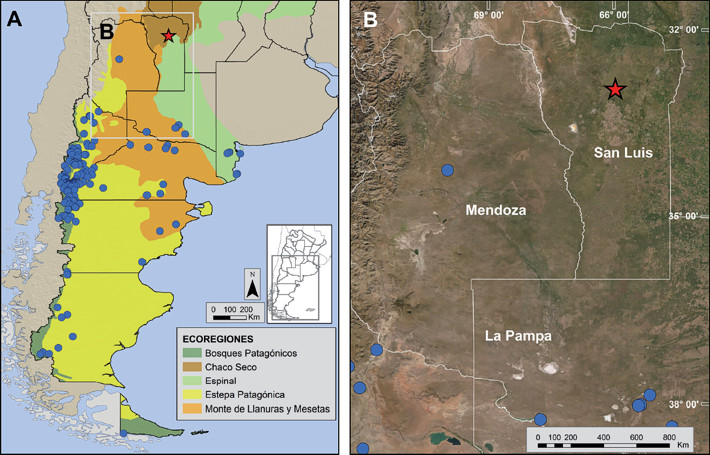First record of Oligoryzomys longicaudatus (Bennett, 1832) (Rodentia, Cricetidae, Sigmodontinae) in San Luis province and the Dry Chaco, Argentina
DOI:
https://doi.org/10.31687/SaremNMS22.8.2Keywords:
biodiversity, common colilargo, Dry Chaco, geographic distribution, new recordAbstract
Oligoryzomys longicaudatus is distributed along the eastern and western slopes of the Andes in the extreme south of South America. In southern Argentina it has a relatively well-known distribution, but towards the north, coinciding with the existence of apparently discontinuous populations, its geographical limits are not well established. During a review of specimens of Oligoryzomys housed at the Colección Mamíferos Lillo, we recorded two specimens coming from the province of San Luis that were assigned to this species based on quantitative and qualitative comparisons of the skull. Regarding these specimens, we cite the species for the first time for this province and the Dry Chaco, highlighting the importance of this record for the knowledge of its distribution.
References
Andreo, V., G. Glass, T. Shields, C. Provensal, & J. Polop. 2011. Modelling potential distribution of Oligoryzomys longicaudatus, the Andes Virus (genus: Hantavirus) reservoir, in Argentina. EcoHealth 8:332–348. https://doi.org/10.1007/s10393-011-0719-5.
Arana, M. D., et al. 2021. Esquema biogeográfico de la República Argentina. Opera Lilloana 56. Fundación Miguel Lillo, San Miguel de Tucumán.
Barquez, R. M., M. M. Díaz, & R. Ojeda (eds.). 2006. Mamíferos de Argentina: sistemática y distribución. Sociedad Argentina para el Estudio de los Mamíferos, Mendoza.
Bauni, V., C. Bertonatti, & A. Giacchino (eds.). 2021. Inventario biológico argentino: vertebrados. 1ª ed. Fundación de Historia Natural Félix de Azara, Ciudad Autónoma de Buenos Aires.
Burkart, R., N. Barbaro, R. O. Sanchez, & D. A. Gómez. 1999. Eco-regiones de la Argentina. Administración de Parques Nacionales, PRODIA, Buenos Aires.
Carbajo, A. E., & U. F. J. Pardiñas. 2007. Spatial distribution model of a Hantavirus reservoir, the long-tailed colilargo (Oligoryzomys longicaudatus), in Argentina. Journal of Mammalogy 88:1555–1568. https://doi.org/10.1644/06-MAMM-A-183R1.1.
Carrizo M. C., et al. 2020. Marsupiales y roedores de la provincia de San Luis. 1ª ed. Nueva Editorial Universitaria – UNSL, San Luis.
Cirignoli, S., P. Teta, U. F. J. Pardiñas, & G. D'Elía. 2006. Oryzomyini Vorontzov, 1959 (sensu Voss y Carleton, 1993). Mamíferos de Argentina: sistemática y distribución (R. M. Barquez, M. Díaz, & R. Ojeda, eds.). Sociedad Argentina para el Estudio de los Mamíferos, Mendoza.
Díaz, M. M., & R. M. Barquez. 2002. Los Mamíferos de Jujuy, Argentina. Literature of Latin America (L.O.L.A.), Buenos Aires.
Flores, D. A., & M. M. Díaz. 2002. Extensión austral a la distribución conocida de Micoureus constantiae (Didelphimorhia, Didelphidae). Acta Zoológica Mexicana (n.s.) 86:239–242.
Hershkovitz, P. 1962. Evolution of Neotropical cricetine rodents (Muridae) with special reference to the phyllotine group. Fieldiana: Zoology 46:1–524.
Massoia, E., & A. Fornes. 1967. El estado sistemático, distribución geográfica y datos etoecológicos de algunos mamíferos neotropicales (Marsupialia y Rodentia) con la descripción de Cabreramys, género nuevo (Cricetidae). Acta Zoologica Lilloana 23:407–30.
Murua, R., & L. A. Gonzalez. 1982. Microhabitat selection in two Chilean cricetid rodents. Oecologia 52:12–15. https://doi.org/10.1007/BF00349005.
Patton, J. L., U. F. J. Pardiñas, & G. D'Elía (eds.). 2015. Mammals of South America, Volume 2: Rodents. The University of Chicago Press, Chicago and London.
Porcasi, X., G. E. Calderón, M. Lamfri, M. Scavuzzo, M. S. Sabattini, & J. J. Polop. 2005. Predictive distribution maps of rodent reservoir species of zoonoses in Southern America. Mastozoología Neotropical 12:199–216.
Teta, P., J. P. Jayat, & P. E. Ortiz. 2016. Notes on the distribution of the genus Andalgalomys (Rodentia, Cricetidae), with the first record for A. pearsoni (Myers, 1978) in Argentina. Mammalia 80:667–671. https://doi.org/10.1515/mammalia-2015-0118.
Teta P., J. P. Jayat, & P. E. Ortiz. 2022. Una nueva especie del género Microcavia (Rodentia, Caviidae) para las tierras altas del noroeste de Argentina. Therya 13:103–114. https://doi.org/10.12933/therya-22-1217.
Teta, P., R. A. Ojeda, S. O. Lucero, & G. D'Elía. 2017. Geographic variation in cranial morphology of the Southern Mountain Cavy, Microcavia australis (Rodentia, Caviidae): taxonomic implications, with the description of a new species. Zoological Studies 56:1–18. https://doi.org/10.6620/ZS.2017.56-29.
Vadell, M. V., I. E. Gómez Villafañe, & A. E. Carbajo. 2020. Hantavirus infection and biodiversity in the Americas. Oecologia 192:169–177. https://doi.org/10.1007/s00442-019-04564-0.
Voss, R. S. 1991. An introduction to the Neotropical muroid rodent genus Zygodontomys. Bulletin of the American Museum of Natural History 210:1–113.
Weksler, M., & C. R. Bonvicino. 2015. Genus Oligoryzomys Bangs, 1900. Mammals of South America, Volume 2: Rodents (J. L. Patton, U. F. J. Pardiñas, & G. D'Elía, eds.). The University of Chicago Press, Chicago and London.

Downloads
Published
How to Cite
Issue
Section
License
Copyright (c) 2022 J. Pablo Jayat, Pablo Teta

This work is licensed under a Creative Commons Attribution-NonCommercial 4.0 International License.

